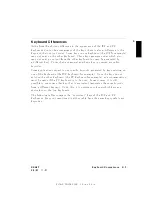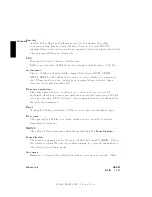
FINAL
TRIM
SIZE
:
7.0
in
x
8.5
in
D
Keyboard
Differences
Aside
from
the
ob
vious
dierence
in
the
app earance
of
the
ITF
and
PC
k
eyb oards
due
to
the
arrangement
of
the
k
eys,
there
is
also
a
dierence
in
the
k
eys
and
their
output
co des.
Some
k
eys
on
one
k
eyb oard
(the
ITF
for
example)
may
not
exist
on
the
other
k
eyb oard.
These
k
eys
generate
co des
whic
h
also
may
not
exist
as
output
from
the
other
k
eyb oard
(or
may
b e
generated
b
y
a
dieren
t
k
ey).
Co
des
that
are
generated
when
a
k
ey
is
pressed
are
called
keyc
o
des
.
Some
applications
exp ect
to
use
sp ecic
keyc
o
des
generated
b
y
k
eys
existing
on
one
of
the
k
eyb oards
(the
ITF
k
eyb oard
for
example).
Since
the
k
eys
do
not
exist
on
the
other
k
eyb oard
(the
PC
k
eyb oard
for
example),
an
accommo
dation
m
ust
b e
made
if
the
PC
k
eyb oard
is
to
b e
used.
In
most
cases,
it
is
still
p ossible
to
use
some
other
k
ey
that
is
equiv
alen
t
(generates
the
same
keyc
o
de
from
a
dieren
t
k
eycap).
T
o
do
this,
it
is
necessary
to
kno
w
whic
h
k
eys
are
equiv
alen
t
on
the
t
w
o
k
eyb oards.
The
follo wing
tables
compare
the
\equiv
alen
t"
k
eys
of
the
ITF
and
PC
k
eyb oards.
Keys
not
men
tioned
in
either
table
ha
v
e
the
same
k
ey
sym
b ols
and
k
eyco des.
DRAFT
2/5/97
11:31
Keyboard
Comparisons
D-3
















































